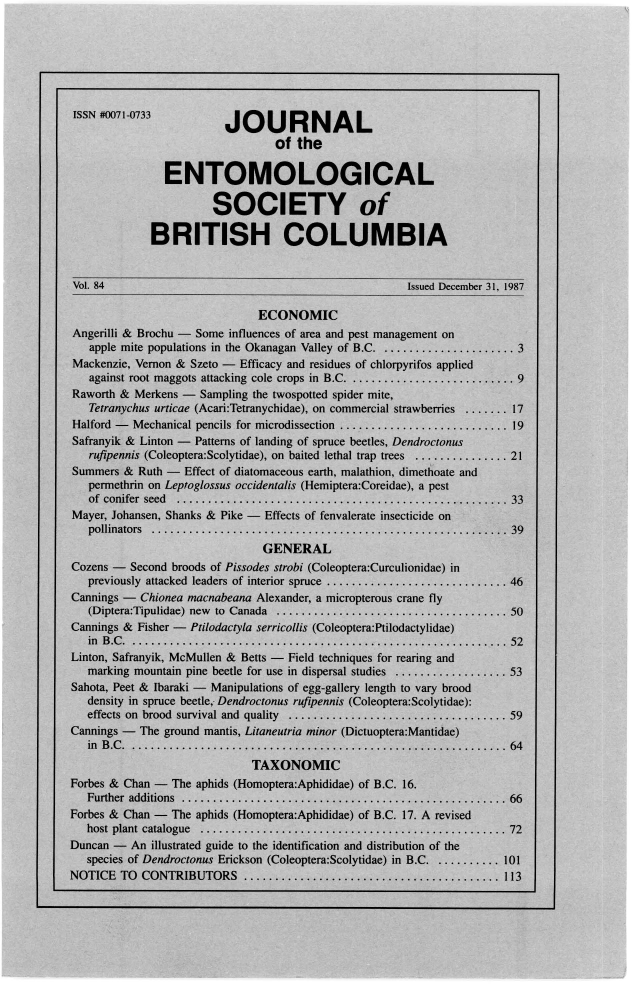Some influences of area and pest management on apple mite populations in the Okanagan Valley of British Columbia
Keywords:
apple miteAbstract
Biweekly leaf samples were taken from commercial apple orchards in four main growing areas, from north to south of the Okanagan Valley, each about 70 km apart, during the full growing season of 1983. Both phytophagous and predacious mite distribution and abundance were influenced by the area and four management practices. Unsprayed orchards had few mites, whereas regularly sprayed orchards tended to have larger mite populations, the species composition and abundance of which varied with area. The numbers of some species of phytophagous mites appeared to be related to the species and abundance of predacious mites present in a given orchard.References
Anderson, N.H. and C.V. Morgan . 1958. The role of Typhlodromus spp. (Acarina: Phytoseiidae) in British Columbia apple orchards. Proc. 10th Int. Cong. Ent. 4:659-665.
Anderson, N. H., C.Y. Morgan, and D.A. Chant. 1958. Notes on occurrence of Tvphlodromus and Phytoseius spp. in southern British Columbia (Acarina: Phytoseiinae). Can. Ent. 90:275-279.
Downing, R.S. and T.K. Moilliet. 1971. Occurrence of phytoseiid mites (Acarina: Phytoseiidae) in apple orchards in south central British Columbia. J. Ent. Soc. B.C. 68:33-36.
Downing, R.S. and T.K. Moilliet. 1972. Replacement of Typhlodromus occidentalis by T. caudiglans and T. pyri (Acarina: Phytoseiidae) after cessation of sprays on apple trees. Can. Ent. 104:937-940.
Downing, R.S. and J. Arrand. 1976. Integrated control of orchard mites on apple in British Columbia. Can. Ent. 108:77-81.
Morgan, C.Y., D.A. Chant, N.H. Anderson, and G.L. Ayre. 1955. Methods for estimating orchard mite populations, especially with the mite-brushing machine. Can. Ent. 87:189-200.
Downloads
Published
Issue
Section
License
Authors who publish with the Journal of the Entomological Society of British Columbia agree to the following terms:
-Authors retain copyright and grant the journal right of first publication with the work simultaneously licensed under a Creative Commons Attribution License that allows others to share the work with an acknowledgement of the work's authorship and initial publication in this journal.
-Authors are able to enter into separate, additional contractual arrangements for the non-exclusive distribution of the journal's published version of the work (e.g., post it to an institutional repository or publish it in a book), with an acknowledgement of its initial publication in this journal.
-Authors are permitted and encouraged to post their work online (e.g., in institutional repositories or on their website) prior to and during the submission process, as it can lead to productive exchanges, as well as earlier and greater citation of published work (See The Effect of Open Access).


